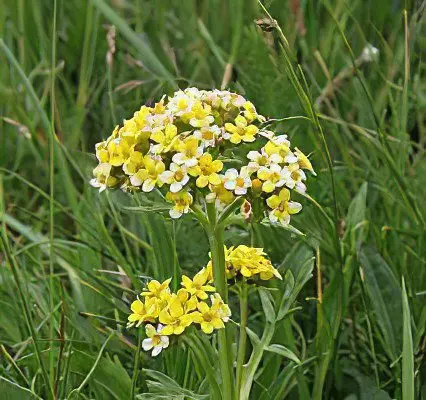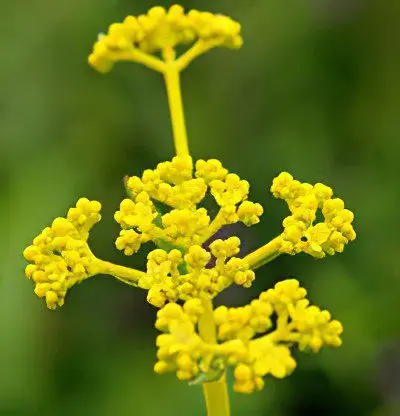Contents
Useful properties and application of Siberian Patrinia
Botanical characteristics of patrinia

Patrinia is a perennial herbaceous plant of the valerian family. Its erect stem 0,3–1,2 m high is covered with short hairs. The rhizome of the plant is multi-headed, long, thick, gray at the break. Leaves basal, pinnate or incised, arranged oppositely. The lower leaves fall off early. The flowers at the ends of the stems are collected in dense corymbose inflorescences of bright yellow color. The fruits are membranous, slightly fluffy.
Patrinia blooms in June-July. It grows in meadows and rare forests of the Far East and Siberia, in the foothills of Central Asia, in Kazakhstan and Altai. It can be found on coastal pebbles and sands, gravel and rocky mountain slopes.
Useful properties of patrinia
The chemical composition of the plant contains saponins, fructose, rhamnose, xylose, oleanolic acid, vitamins A, C, D and essential oil. The roots contain a significant amount of alkaloids. For medicinal purposes, the roots and rhizomes of the plant are used, less often the grass. Raw materials are dug up in the second half of summer and autumn, cleaned of earth, remnants of stems and leaves, finely cut, dried in the shade in the air.
Application of Patrinia
In scientific medicine, the plant is used as a substitute for valerian. In terms of the strength of the sedative effect and the regulating effect on the heart muscle, it is significantly superior to valerian. Preparations from patrinia are prescribed for insomnia, increased excitability and heart neuroses. In folk medicine, plant-based remedies are recommended for enteritis, gastroenteritis, enterocolitis, as well as for disorders of the nervous system. Decoctions and infusions of herbs are effective for pulmonary diseases, including pulmonary tuberculosis.
Decoctions are used as an emetic, they are effective for bleeding, hemoptysis, cystitis, fever, thrombosis. Dosage forms of patrinia help with jaundice, malaria, hepatic and renal colitis. It is a good anti-toxic agent.
Patrinia infusion: 2 tablespoons of the crushed rhizome of the plant must be poured with 200 ml of water, insisted for 2 hours in a dark, cool room, strained and consumed after meals, 1 tablespoon.
Patrinia sibirica
This light-loving perennial herbaceous plant has a thick long root, from which several erect stems grow. The flowers of the Siberian Patrinia are bright yellow, grow at the ends of the stems, collected in dense paniculate inflorescences. Basal leaves are entire, above – pinnate or incised. This species blooms in June-July, does not tolerate excess moisture.
The plant is listed in the Red Book of the Middle Urals and the Republic of Bashkortostan. It is distributed in Central and Eastern Siberia, on about. Sakhalin, the Kuril Islands, in Northeast China and Japan, grows on gravelly and rocky mountain slopes.
For medicinal purposes, the rhizomes and roots of the plant are used. In folk medicine, patrinia is used as a sedative, hemostatic and anti-inflammatory agent. Scientific methods have revealed that it has a detrimental effect on some pathogenic fungi, including the causative agent of ringworm, and also increases blood clotting.
Patrinia scabiosolifolia

This is a perennial herb. Its stem is bare or slightly pubescent, branched. Leaves, strongly spread apart, grow in pairs at the base of the branches. Basal leaves die off early. Small yellow flowers are collected in a paniculate corymbose inflorescence. This species blooms in June-July. Distributed in Siberia, Mongolia, Korea, China, the Far East, grows in steppe and subalpine meadows, in rare forests.
In folk medicine, the aerial part of the herb is used in the treatment of pulmonary tuberculosis, bleeding, acute gastro- and enterocolitis, as well as many other diseases that occur with fever. Preparations from patrinia scabiosol have antiseptic, choleretic, diuretic, astringent and tonic properties. As an external anti-inflammatory agent, the plant is used for postpartum complications, malignant tumors, infected wounds, parasitic skin diseases.
Contraindications to the use of Patrinia
The use of patrinia preparations in diseases of the oral cavity can cause irritation of the mucous membrane. They are also contraindicated in thrombosis, hypotension. In case of an overdose of drugs, headache and sleep disturbance may occur.









